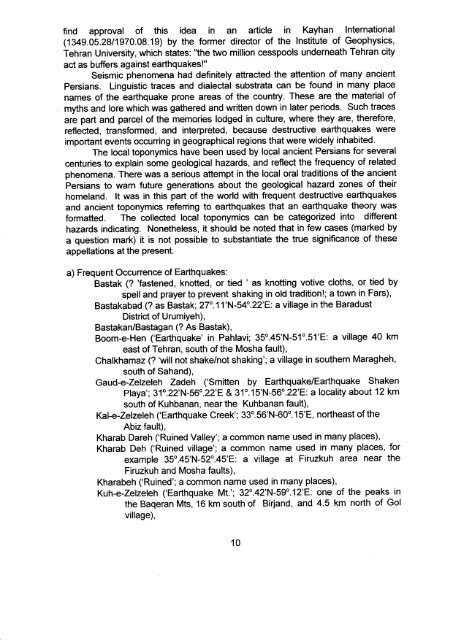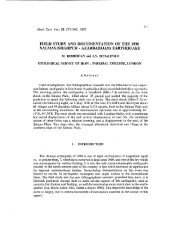PDF COPY - Manuel berberian
PDF COPY - Manuel berberian
PDF COPY - Manuel berberian
You also want an ePaper? Increase the reach of your titles
YUMPU automatically turns print PDFs into web optimized ePapers that Google loves.
find approval of this idea in an article in Kayhan International(1349.05.28/1970.08.19) by the former director of the Institute of Geophysics,Tehran Universig, which states:"the two million cesspools underneath Tehran cityact as buffers against earthquakes!"Seismic phenomena had definitely attracted the attention of many ancientPersians. Linguistic traces and dialectal substrata can be found in many placenames of the earthquake prone areas of the country. These are the material ofmyths and lore which was gathered and written down in later periods. Such tracesare part and parcel of the memories lodged in culture, where they are, therefore,reflected, transformed, and interpreted, because destructive earthquakes wereimportant events occurring in geographical regions that were widely inhabited.The localtoponymics have been used by local ancient Persians for severalcenturies to explain some geological hazards, and reflecthe frequency of relatedphenomena. There was a serious attempt in the local oral traditions of the ancientPersians to warn future generations about the geological hazard zones of theirhomeland. lt was in this part of the world with frequent destructiv earthquakesand ancient toponymics referring to earthquakes that an earthquake theory wasformatted. The collected local toponymics can be categorized into differenthazards indicating. Nonetheless, it should be noted that in few cases (marked bya question mark) it is not possible to substantiate the true significance of theseappellations at the present.a) Frequent Occurrence of Earthquakes:Bastak (? 'fastened, knotted, or tied ' as knotting votive cloths, or tied byspell and prayer to prevent shaking in old tradition!; a town in Fars),Bastakabad (? as Bastak; 27o.11'N-54o.22'E: a village in the BaradustDistrict of Urumiyeh),Bastakan/Bastagan (? As Bastak),Boom-e-Hen ('Earthquake' in Pahlavi; 35o.45'N-51o.51'E: a village 40 kmeast of Tehran, south of the Mosha fault),Chalkhamaz (? 'will not shake/not shaking'; a village in southern Maragheh,south of Sahand),Gaud-e-Zelzeleh Zadeh ('smitten by Earthquake/Earthquake ShakenPlaya'; 31o.22'N-56o.22'E & 31o.15'N-56o.22'E: a locality about 12kmsouth of Kuhbanan, near the Kuhbanan fault),Kat-e-Zelzeleh (' Earthq uake C reek' ; 33o. 56' N-60o. 15' E, northeast of theAbiz fault),Kharab Dareh ('Ruined Valley'; a common name used in many places),Kharab Deh ('Ruined village'; a common name used in many places, forexample 35o.45'N-52o.45'E: a village at Firuzkuh area near theFiruzkuh and Mosha faults),Kharabeh ('Ruined'; a common name used in many places),Kuh-e-Zelzeleh ('Earthquake Mt.'; 32o.42'N-59o.12'E: one of the peaks inthe Baqeran Mts, 16 km south of Birjand, and 4.5 km north of Golvillage),10







